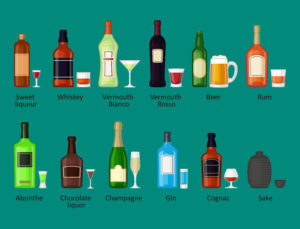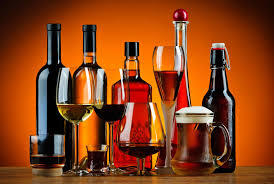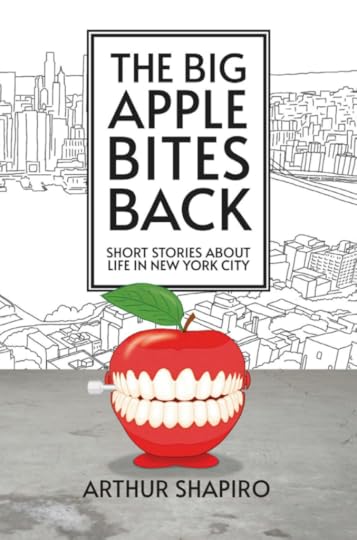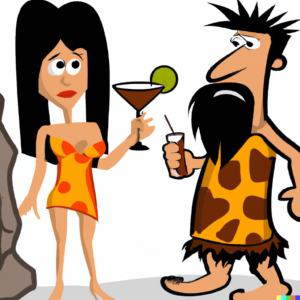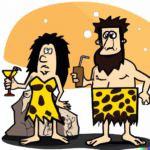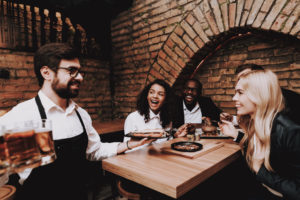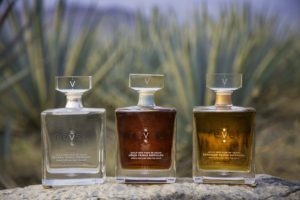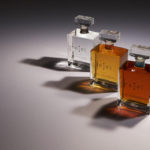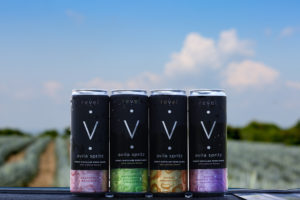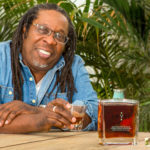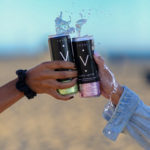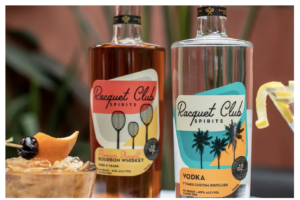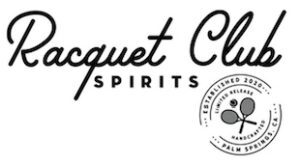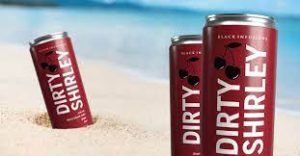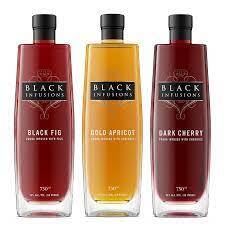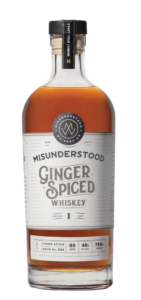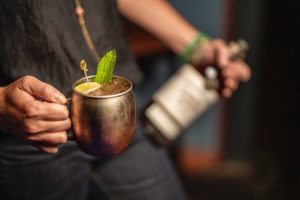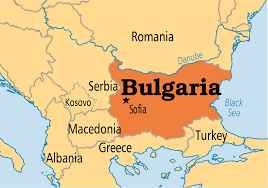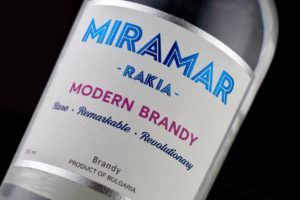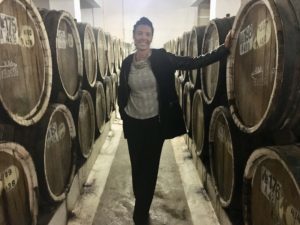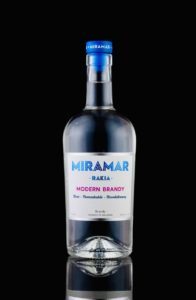Arthur Shapiro's Blog
July 9, 2024
The State of the Booze Business: What Does the Future Hold?
Here is a close look at the key factors affecting the industry.
The “sober curious” movementThe sober curious movement is a lifestyle approach where people become more mindful about their alcohol consumption without necessarily committing to complete abstinence. It involves deciding if, when, and why to drink. Dry January is a good example.
One of the key factors driving the non-alcohol trend is the ‘sober curious’ movement.
Non-alcohol beverages growthThis shift is strongest among younger generations, with Gen Z (born 1997-2012) drinking over 20% less than other generations did at their age. The non-alcohol beverage market is expected to grow 31% by 2024, making it the third fastest-growing beverage category in the U.S. Source.
This shift is reflected in the market with beer sales stagnating, wine offering alcohol-free alternatives, and spirits brands introducing non-alcohol versions of cocktails.
PremiumizationThis is not a new trend; it has grown for years, if not decades, and is accelerating.
First and probably foremost is drinking at home. Most Americans say they consume alcohol at home, and 46% of those surveyed say they are likely to treat themselves to premium options there. In addition, the longstanding idea of “drinking less but drinking better” continues to apply.
Premiumization is most notable in spirits. Overall, 33% of Americans said they had spent $50 or more on a bottle of alcohol in 2022, against just 24% in 2021. Furthermore, six in 10 online shoppers say they spend more on alcohol online than in-store. Source.
E-commerce and Direct-to-Consumer (DTC)While some recent reports show a slowing of the DtC market, the growth, driven mainly by Covid, is dramatic. Total beverage alcohol e-commerce sales are expected to grow 66% by 2025, reaching $42 billion annually. This trend is fueled by consumer demand for convenience and the industry’s adaptation to changing purchasing habits.
“IWSR predicts a 2023-27 value compound annual growth rate (CAGR) of 7% for online alcohol sales in the U.S., compared to a total beverage alcohol (TBA) CAGR of 1% over the same period. This would result in e-commerce’s TBA share increasing from 3.2% in 2022 to 3.9% in 2027. However, the 7% growth is a drop on the 11% CAGR prediction estimated for 2022 to 2026.” Source.
Functional BenefitsThere’s a growing interest in functional beverages that offer benefits beyond taste and alcohol content. The functional beverage market is projected to reach $261 billion by 2032, with a CAGR of 6.5%. These drinks often include added vitamins, minerals, or other health-promoting ingredients.
From Clarkston Consulting:
“While functional beverages themselves aren’t a new concept, the development of functional alcoholic beverages is relatively new to the industry. One of the driving brands in this market, Vizzy, offers fortified alcohol products designed to incorporate vitamins and antioxidants into the drinking experience. Other beverages released include Hard Kombucha, which is low-calorie, made with real fruit, and has an assortment of other natural benefits while still providing the desired alcohol content. FitVine has also released wines that stand out for zero sugar content without compromising flavor or ABV.”
Ready-to-drink (RTD) Cocktails and Canned BeveragesRTD cocktails and canned beverages continue to gain popularity, offering convenience and portability. This category is currently the fastest-growing product in the industry and is expected to earn an additional 8% of the market by 2025. The trend is driven by consumers seeking easy-to-consume options for various occasions.
The RTD alcoholic beverages market was estimated at $18.7 billion in 2023 and is expected to reach $28.6 billion in 2033, growing at a compound annual growth rate of 7.9%, according to this report.
Cannabis-Infused BeveragesThis is a trend/prediction that is well worth considering or, perhaps, troubling.
As cannabis legalization expands, THC-infused beverages are emerging as a potential competitor to traditional alcoholic drinks. The cannabis-infused drinks market is projected to grow at a CAGR of 37.8%, reaching $8.7 billion in annual sales by 2032. Source.
According to a recent report on CNBC, for the first time, more Americans are using marijuana on a daily or near-daily basis than alcohol. In addition, from 1992 to 2022, the per capita rate of daily or near-daily cannabis use increased 15-fold.
Other areasSustainability and Eco-Friendly Packaging: Introducing recyclable or biodegradable packaging and reducing carbon footprints in production and distribution, to name a few.Craft and Artisanal Products: While the craft beer boom has somewhat stabilized, there’s still strong interest in craft and artisanal products across all alcohol categories. Craft spirits are seeing growth as consumers seek unique and locally produced options. Source# # #
The best way I know to summarize the changing climate for the alcohol industry is to leave you with a favorite quote from Peter Drucker, the renowned management consultant.
“A time of turbulence is a dangerous time, but its greatest danger is the temptation to deny reality.”The post The State of the Booze Business: What Does the Future Hold? first appeared on Booze Business: A Blog Dedicated to the Business of Spirits and Wine.December 8, 2023
My New Book
July 6, 2023
Happy Hour in a Stone Age Cave: A Fable
I’ve been off the air for too long, but I have an excused absence — I’ve been working on my new book. It’s called The Gig Apple Bites Back. It’s a collection of short stories about NYC, none of which are about the booze business. The manuscript is done, and now it’s time to go back to this blog.
The story, or fable, below occurred to me when I was writing about the history of alcohol. I hope you like it.
Hagbah and Gelilah were partners. They lived in a two-story walkup cave somewhere in Asia-Pacific. Hagbah was a terrific hunter and the alpha male in the area. Gelilah was a ravishing beauty and the foremost gatherer in the valley. They did okay. Not rich but comfortable.
The start of their relationship was rocky, especially when Hagbah broke into her parent’s cave, hit her over the head, and dragged her off. Her parents, recognizing this act of endearment, were proud that the prominent Hagbah selected her. When she came to, Gelilah was pissed. With an enormous bump on her head and a splitting headache, she grabbed Hagbah by the nether region and said, “Hit me one more time, jackass, and I’ll feed what’s left of you to the T-Rex up the road.” Their relationship improved appreciably after that.
Over time, things settled down with hunting, gathering, and avoiding predators. Although, on one occasion, Gelilah was fed up with Hagbah’s idea of lovemaking and demanded he find a way other than grabbing her from behind while she picked berries. “Listen, Mr. Neanderthal, try a little kindness and gestures of love. Otherwise, go sleep with the pterodactyls.”
Hagbah was a slob among his other faults, and Gelilah had to pick up after him. He would come home from a hunt, throw the meat on the floor along with his animal skins and expect her to clean it up. But what bothered her was that he left a pile of her gatherings everywhere. We’re talking fruit, vegetables, seeds, and other stuff. Just left to rot.
Over time, she noticed a pleasant smell from the rotting debris and its liquid. She tasted it, which was awful, but a big smile crossed her face after a few minutes. Hey, she thought, this isn’t bad. She convinced Hagbah to try it that night. He had the same reaction as her. They drank, they laughed, they relaxed, had fun, and, um, uh, fantastic sex.
Revelations began to emerge. Gelilah wondered why they ate raw meat. Hagbah agreed and remembered that their neighbor Spankle had rubbed some sticks and stones together, and their cave lit up, and their food was hot.
It was decided that the downstairs and upstairs cave dwellers would get together and explore this new phenomenon every day. So, they and Spankle started a group of like-minded cave dwellers to partake of the rotting liquid.
And that’s how the Happy Hour was born.
The post Happy Hour in a Stone Age Cave: A Fable first appeared on Booze Business: A Blog Dedicated to the Business of Spirits and Wine.
September 19, 2022
Revel Avila: A New Agave Spirit and Category
This is the story of an Agave Spirit called Revel, made from 100% agave in Morelos, Mexico, and known as Revel Avila. More about this in a moment.
In the alcohol industry, spirits and wines are protected by law, known as Denomination of Origin. What that means is that it “is a designation that protects geographical status and refers to products specific to a particular region or town, which convey a particular quality or characteristic of the designated area.” (Spirits Beacon)
Some examples: Scotch can only come from Scotland; Champagne can only be called that if it comes from the region with that name; Cognac must come from the Cognac region in southwest France, and so on.
In the world of Agave Spirits, until recently, there were five types of products in Mexico:
Tequila: Must come from Jalisco.
Mezcal: Comes from nine different states, most notably Oaxaca.
Raicilla: It is the same as mezcal — but since it is not made in one of the nine states, it goes by another name. Raicilla comes from the Western side of the state of Jalisco.
Bacanora: Can only be found in the mountains of Sonora, a state in northern Mexico.
Sotol: An Agave Spirit that is technically not an agave spirit. While the base plant, Dasylirion or Desert Spoon, is also in the asparagus family, it is not classified as an agave. Still, the spirit is often roped into the category.
But wait, there’s more. Some time ago, I wrote about Agave Spirits made in India. A Wine Enthusiast article points out that “the plant is now being grown and distilled in California, Australia, South Africa, Peru, Venezuela, India, and elsewhere.”
It is interesting to note that Designation of Origin does not preclude drinkers from choosing Prosecco, Cava, and other sparkling wines; Brandy instead of Cognac; American Single Malt whisky instead of Scotch, etc. Bourbon, however, does not have to be made in Kentucky. Most of the Bourbon comes from KY (over 90%) but also from other states.
Revel Spirits — the ProductIn 2018, Revel Spirits created the new agave-based spirit category and named it Avila. Distilled in Morelos, Mexico, Avila must utilize agave grown within the state’s borders, which boasts a terroir different from other regions in the country. According to Revel Spirits:
“An active volcano to the north provides the state’s nutrient-rich, virgin soil, which produces incredibly healthy and robust agave. REVEL’s award-winning Avila is handcrafted using both roasted and steamed pinas of 100% blue weber agave, a process that yields a flavor profile that combines the smoky notes and characteristics of mezcal with that of tequila.”
It turns out that Revel is the world’s first Avila, but this spirit has been enjoyed in Morelos for generations, with deep local roots in the region. The people of Morelos are incredibly proud of this spirit – Revel is simply giving them a conduit to showcase it to the world by bringing the brands to market.
Avila is offered in three variants: Blanco, which is bottled straight after distillation; Reposado, which is aged for 12 months in ex-whisky oak barrels; and Añejo, a 47% AbV spirit that is aged for 24 months in new French oak barrels.
I’m not a tasting expert or even a tequila/mezcal aficionado, but I found the products very smooth, flavorful, and a combination of the smokiness of mezcal and the characteristics of tequila. Yet, the taste is quite distinctive.
The Flaviar tasting notes included this: “Flavor / Taste / Palate We wish we could call it a Tequila, but we can’t, so we’ll call it very Tequila-like with a rich mouthfeel and notes of cilantro, succulents, mint, white pepper, and a hit of zest.”
In addition to the base brand and variants, Revel Spirits have also produced a line of Ready-to-Drink (RTD) products called Avila Spritz with some unusual flavor combinations (my favorite is Grapefruit Rosemary).
Meet the people behind the brand and new categoryThe founder and CEO of the company is Micah McFarlane, who has spent most of his work life in the music industry as a tour manager. I’m always struck by the ‘smarts’ of some entrepreneurs entering the booze business — eager to learn, adapt their skills, and work their asses off. Micah is all of these and much more. We had a terrific conversation about the similarities between the alcohol and music industries. Both businesses cater to specific consumer tastes, and the packaging is vital, as is promotion activity and dealing with distributors and retailers.
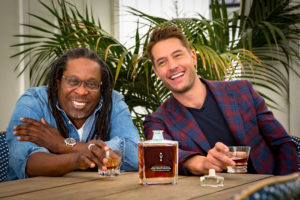 Micah McFarlane (L) and Justin Harley (R)
Micah McFarlane (L) and Justin Harley (R)Speaking of distributors, among the things that impressed me was that Neil Barnett is an advisor to the brand and brought it to my attention. In case you don’t know him (it must be because you are either new to the industry or not in it), Neil was President and COO of Fedway distributors in NJ, the largest independently owned wholesaler. Neil is smart, knows the business better than most, and is very tough and discerning about new products. He is also a great guy, and if he likes a brand, I, for one, will stand up and take notice.
McFarlane partnered with Héctor Ruiz, a restaurateur in Minneapolis and a Morelos native, to bring the agave-based spirit to consumers. Revel Spirits is made at a farm and distillery in Morales, in the south of Mexico, which the Ruiz family owns. For generations, the Ruiz family has produced the agave spirit in Morelos. However, it was only consumed by friends and family until Revel Spirits were formed.
By the way, Micha met Hector Ruiz’s cousin, whose name is Noa Avila, hence the name Revel Avila.
To round out the team, joined as a partner. Justin is an award-winning Actor, Producer, and Director. He starred in NBC’s critically acclaimed, award-winning drama series “This Is Us” and is also known for “Smallville” and “Revenge.”
In addition…Revel Spirits is the steward of this category and takes its role very seriously. They are leading the charge to get the Mexican federal government to grant a Denomination of Origin protecting Avila and ensuring that no spirit can bear that name unless it’s produced using agave grown and distilled within the borders of the state of Morelos.
During the Covid pandemic, Revel Avila donated 30% of the profits from online sales to the United States Bartenders’ Guild’s (USBG) Covid-19 relief fund to support on-trade workers during the pandemic.
Revel is available in 13 states — CA, TX, ND, MN, MA, NY, NJ, NV, MN, KS, MD, RI, and CT, with more on the way. It’s also available online at ReserveBar and Flaviar.
The Blanco sells for around $50; Reposado for roughly $70; and the Añejo for $175.
# # #
Just this past week, two major industry resources have pointed out the impact on tequila from other agave spirits:
IWSR —”Is Tequila Under Threat?” Link
The Spirits Business — “Alternative agave spirits could challenge tequila.” Link
The post Revel Avila: A New Agave Spirit and Category first appeared on Booze Business: A Blog Dedicated to the Business of Spirits and Wine.August 31, 2022
Do Awards and Medals Matter?
Every day, spirit brands seem to be crowing about the awards or accolades they have won. Whether meaningful or not, press releases and brand pitches abound with “we won this” or “we won that” to the point where I often wonder what difference it makes.
At the same time, the purveyors of the award programs are all over the place with implicit vows of brand supremacy and recognition. They seem to be saying that if you enter our contest or event and vie for glory, not to mention recognition, you’ll succeed.
So, let’s take a brief look at awards and accolades from several viewpoints — the awards in general, the trade, the makers, and the impact on consumers. Let’s separate fact from myth, with a few opinions thrown in.
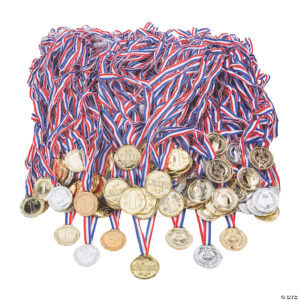 Int’l games award medals. Oriental Trading co.
Int’l games award medals. Oriental Trading co.Fact: Major and mainstream brands don’t need or use awards as a distinguishing characteristic. Of course, they don’t need to at this stage in their development. But, even at the outset, brands like Tito’s, Patron, Absolut, Bulleit, and others did not use accolades as a reason for being. Perhaps it was because there were far fewer award contests or because their message, brand attributes, and market positioning were sufficient to win over the trade and consumer.
The only exception I’ve seen is on behalf of line extensions, and then only sporadically. I suspect that a zealous brand manager from a top brand managing a line extension will be attracted to enter the brand in an award contest to show management that the investment in the extension is worthwhile. (Not to mention how great they manage the brand.)
Opinion: Among award suppliers, not all are created equal. I’m not looking to review these companies or make any recommendations, but the two that stand out, in my opinion, are the Ultimate Spirits Challenge and San Francisco Spirits Competition. Sure, there are many other excellent suppliers, but I’m impressed with these two because of their longevity, the people who run them, and the acumen of the judges most of the time.
Speaking of judges, that’s a critical dimension. I have a client and friend who entered his craft product in both these events. Interestingly, one is on the east coast, and one is on the west: same product but markedly different scores. There must be palate differences east and west — why else would he have received double gold in one place and bronze in the other? The only further explanation is that the product produced in one area reflected the taste of that area but didn’t translate across the country.
Fact: Craft brands enter contests that they presume will enhance their go-to-market ability. It’s about recognition and trying to influence distributors and retailers.
Fact: If a craft brand has deep enough pockets, they can enter tons of award events and collect medals (some meaningful, most not) and get lots of bragging rights.
Fact: The best aspect of awards is the opportunity for brand publicity and use on social media.
Fact: But…It’s not about the award itself; it’s how to monetize it.
Fact: Awards don’t build brands. A unique and relevant proposition, together with sound strategies and tactics, and pounding the pavement is what it takes. There are no shortcuts.
Myth: The trade cares about brand awards. The reality is that they look at new brand awards, and it becomes a sort of ‘ticket of admission.’ For many, it’s like chicken soup when you have a cold; it might not help but can’t hurt.
That’s because…
Fact: Brand awards are overdone and a dime a dozen.
Myth: Consumers focus on awards in their decision-making process.
Let’s get real — there are tons of prizes and brands shouting about them — some are multiple golds and some ‘honorable mention;’ some are from no-name award events, some from meaningful ones. Who has time or interest in considering awards to make a purchase?
I’ll tell you what, in my experience, works best — a number on a shelf talker (adjacent to the bottle). A rating of 90+ captures the attention of someone looking to try something new and has more meaning than tons of not understood and pointless glitter. Thank you, wine industry, for using numeric ratings in highlighting top wine brands.
Fact: The only people benefiting from awards are the organizers of the award events. A close second is the brand owner, who thinks that awards are the quick and easy way to succeed.
# # #
If I were to be philosophical and more than a little meanspirited (who me?) I’d say that the award culture we live in stems from the past 40 years or so, starting with camps, organized sports, and other efforts, whereby just showing up earned an award, plaque, or trophy. As my friend and business partner, Rob Warren, says, “It’s the syndrome where everyone who plays or pays gets an award.”
Sure, show them an award or two as an aside, but not the focal point of your brand proposition. To win in the booze business, you need way more than that.
Let me know what you think.
The post Do Awards and Medals Matter? first appeared on Booze Business: A Blog Dedicated to the Business of Spirits and Wine.August 2, 2022
Welcome to California: Racquet Club Spirits
 The Story of a New Craft Spirit Company in Palm Springs
The Story of a New Craft Spirit Company in Palm SpringsIn the past year or so, I’ve been off the air for several reasons — business and writing commitments, Covid, and most important, moving from NYC to Rancho Mirage CA. That’s in Coachella Valley, aka Greater Palm Springs, aka The Desert.
Now I’m back and at it. And what does a transplanted New Yorker and booze business writer/observer do? Looks for places to eat and drink (restaurants and bars here are top notch) and entrepreneurs in the Booze Business.
Meet the Owners of Racquet Club Spirits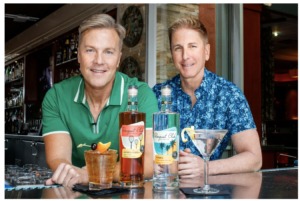 Matthew Winks and Brian Harke, owners of Racquet Club Spirits
Matthew Winks and Brian Harke, owners of Racquet Club SpiritsFrom Palm Springs Life magazine: “The spirit of individuality and fun from the historic Racquet Club spur a desert couple to create a new Palm Springs-inspired liquor brand. A marketing director and commercial producer together for more than 30 years, Movie Colony couple Brian Harke and Matthew Winks have spun their passion for cocktails into a new line of Palm Springs-inspired spirits, Racquet Club Spirits.”
Racquet Club Spirits is an LGBTQ+ owned company, and producers of Racquet Club Vodka and Racquet Club Straight Bourbon Whiskey. Two truly outstanding products in my view.
The owners, Brian and Matthew, come from outside the Booze Business world but have quickly learned the business and what it takes to succeed. Brian was a marketing director, and Matthew was a TV commercial producer. They used their creative background to work on the classic bottle design with a vintage label.
Their brand launch announcement described their effort this way:
“Racquet Club Spirits celebrates the style and swagger of Palm Springs Racquet Club, a desert oasis that became Hollywood’s legendary playground. The Vodka and Straight Bourbon Whiskey are hand crafted in small batches to ensure that every classic cocktail lives up to their namesake: the exclusive Racquet Club, where movie stars went to escape.”
About the Racquet ClubCoachella Valley and Palm Springs is known for its midcentury architecture, outdoor leisure and history of attracting Hollywood celebrities.
In fact, when we first moved out here, we were thrilled and amused by many of the street names throughout the valley: Dinah Shore Drive, Kirk Douglas Way, Frank Sinatra Drive, Fred Waring Way, Gene Autry Trail, and so on. It’s a fun place to live. (But don’t ask me about the heat.)
In an interview in Palm Springs Life, Matthew described the environs this way:
“Palm Springs is similar to Las Vegas in that for years and years, people have come here to escape. The Racquet Club was certainly part of that because movie stars felt comfortable going and hanging out there. It was beyond the studio zone in the old days of Hollywood, so they were allowed to let loose. That spirit of individuality and fun really connected to us and our vibe.”
In my view, the inspiration of the Palm Springs area, especially its history, sends a message to consumers that this brand is fun, special, and transfers those attitudes to the drinking occasion.
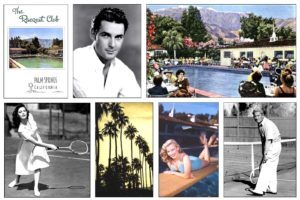 The Racquet Club circa 1930s. From ladyevesreellife.com
The Racquet Club circa 1930s. From ladyevesreellife.comThe Racquet Club was founded in 1934 by actors Ralph Bellamy and Charlie Farrell so they would always have a court to play in. It served as a gathering place and party venue for much of Hollywood’s show business elite and quickly became the party spot for Hollywood royalty including Lana Turner, Kirk Douglas, Elizabeth Taylor, Errol Flynn, Spencer Tracy, Clark Gable, Natalie Wood, and Robert Wagner who were regular guests. Marilyn Monroe is said to have been discovered there.
The Products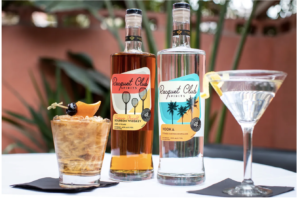
The tradition and lifestyle of the Racquet Club and Palm Springs drove their business proposition — laid back, easy-going, and as they put it, laden with style and swagger. The packaging certainly reflect this with the non-traditional label and more importantly the retro look.
While they do not distill themselves, they have worked very closely with distillers to manufacture products to their vision. Namely products that taste good and makes drinkers feel the Palm Spring vibe.
Their mandate for the vodka was that it had to have notes of vanilla with a soft nonmedicinal aroma or mouthfeel, and fruit over notes. In addition, it is filtered 7 times using a carbon with all-natural carbon originating from coconut husks. Palm Springs all the way.
The distiller is Dry Diggings Distillery, El Dorado Hills, CA. It sells for roughly $32.99 and is 80 proof (40 AbV).
The bourbon is made by Midwest Grain Products (MGP), again with Brian and Matthew’s oversight. I found it very gentle and easy to drink straight yet held up and complimented my favorite cocktail. Again, it’s got a bit of fruitiness and is well balanced, so it lends itself to mixology. There’s a bit of caramel and vanilla with some chocolate notes in there.
It’s 84 proof (42 AbV) and sells for about $42.99.
Both products are available all over the Palm Springs area in top bars and restaurants and in such off-premise accounts like Total Wine and More, Mirage Wine & Liquor, and other leading independents in the valley, and online.
The vodka has won several awards including a silver award from the NY World Wine and Spirits competition. The bourbon has received two double gold awards from the Sip Awards and the San Diego Spirits Festival.
# # #
If you’ve been a follower of this blog, you know that I appreciate startup entrepreneurs who change their work lives and enter the alcohol industry. In Brian and Matthew’s case, I especially admire their vision and their hard work to bring it to fruition. When I spoke with them recently, I was struck by their passion and drive, which was very palpable.
Welcome to the Booze Business gentlemen.
The post Welcome to California: Racquet Club Spirits first appeared on Booze Business: A Blog Dedicated to the Business of Spirits and Wine.June 16, 2022
The Best Dirty Shirley: More than the drink of the summer
 The Shirley Temple Grows Up
The Shirley Temple Grows UpThe internet, press, and TV are all abuzz with the Dirty Shirley. It’s described as the drink of the summer 2022. The NY Times was among the first to write about it. The Today Show recently went so far as to describe it as overtaking the Aperol Spritzer as the summer drink.
So, it’s not surprising that I thought this drink was worth looking into. Among the first thing I came across was this press release from Black Infusions, makers of Black Fig (Double Gold at San Francisco Spirits Competition), Gold Apricot (96 points from Wine Enthusiast), and their newest product, Dark Cherry. The latter addresses the Dirty Shirley two ways — used as a cocktail at bars and restaurants and a canned version as a Ready-To-Drink (RTD) cocktail.
Black Infusions was created and is owned by the husband-and-wife team, of Michael and Barbara Davidson. I’ve known them since 2018 and wrote about them then. I figured I’d check in with them and learn more about what’s going on in general and with their brands. So, we spoke at length on the phone and here’s the interview:
BB: Before we get into the Dirty Shirley… how’s business overall?
Michael: Business is good, we’re gaining traction from consumers, largely because of our retail distribution. But, you know, it can always be better, so we keep pounding the pavement.
BB: What accounts are you in?
Michael: Off-Premise we’re in Total Wine & More, Kroger, Wegman’s, Whole Foods, Stew Leonard’s, and more. On-Premise we’re in a range of what you might called “marquis” accounts like Fig & Olive, Balthazar, Eleven Madison, Jean-George’s restaurants, and a bunch of others.
BB: How did the Dark Cherry infused vodka come about?
Michael: Our position in the market is based on vodka naturally infused with fruit — just fruit and neutral grain spirits, no artificial flavors, no other additives, no extra sugar. At 60 proof, consumers love our Black Fig and Gold Apricot products because they can enjoy it by itself and in cocktails. When we thought about other products, cherries came immediately to mind.
Barbara: I would add that finding the right blend and especially the right cherries, took time. Like some fine wines, we needed to find the right balance of cherry types. Our blend is 80% Bing Cherries and 20% Rainer.
BB: And how did the RTD product come about?
Michael: Lots of our bartender fans and friends kept making different kinds of drinks with Dark Cherry. One was a Cherry Coke. But the one that got our attention was a Shirley Temple with Dark Cherry vodka… The Dirty Shirley. Then…
Barbara: We felt that just adding vodka to the traditional recipe was wrong. If you order a Dirty Shirley at a bar, the recipe calls for lemon lime soda like sprite, grenadine, and maraschino cherries. Much too sweet and artificial tasting. When we taste our product with the trade, the response we got was, “You ought to put it in a can as an RTD.” So, we did.
Also, It’s special, unique, it’s fun, it’s yummy, and after the last two years, I figured we could all use a reminder of simpler times. Our new Dark Cherry vodka gives us a delicious yet all-natural twist with the convenience of a can.
BB: How is it different than the Dirty Shirley made in bars?
Michael: The RTD has our Dark Cherry vodka, fresh lime juice, some real ginger, and a touch of carbonation.
BB: How is it going so far?
Barbara: We just launched in May and only in a few markets, but we can’t keep it in stock.
Michael: From a business standpoint, the RTD will hopefully accomplish several things: promote the Dark Cherry infused vodka as a brand, highlight our full line and raise awareness of our other real fruit products, and perhaps open the door to other RTD entries.
BB: So, it’s not just a new brand, it will play a strategic role.
Michael: That’s right.
BB: Where can my readers find the RTD?
Barbara: We launched in Boston, at Big Night Live and sold 130 cans in 3 hours. BevMo/Gopuff requested availability in CA. We will also launch Gopuff in MA and DC, and Total Wine in MA.
BB: The best of luck with all your products. You’ve come a long way from when we originally met. Here’s to continued success. Thanks for your time.
The post The Best Dirty Shirley: More than the drink of the summer first appeared on Booze Business: A Blog Dedicated to the Business of Spirits and Wine.March 12, 2021
Coole Swan: A Whiter Shade of Cool
According to Impact Databank, Bailey’s Irish Cream is a 1.5 million 9-litre brand in the US and grew 6.5% from 2018 to 2019. But after you read the story about Coole Swan Irish Cream Liqueur, you might wonder if Coole Swan, with the right resources, might just make a dent in those numbers.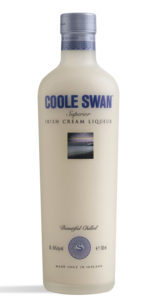
David Gluckman, whom I’ve written about in the past, spent 45 years in the drinks business primarily in the new brand development area. Much of his career, 36 years to be exact, was with International Distillers and Vintners (IDV), the company that became Diageo. Along the way, he created Sheridan’s, Le Piat d’Or, Tanqueray Ten, Bailey’s Irish Cream, among others.
In 2005, he left Diageo and decided that, together with some former clients/colleagues, they would develop products for their own company. As he puts it in his book (That S*it Will Never Sell):
“When I think back, I was isolated from most of the tough stuff… working for a company. All I had to do was come up with ideas. Other people looked at production, finance and marketing. Now that I was working on a brand of my own, I came to realise how difficult things could be at the deep end.”
Among the products they developed was Coole Swan where they saw an opportunity for a product with lower sweetness and more modern, sophisticated packaging which broke with the Bailey’s template.
Currently, the brand is an independently owned family business run by husband and wife team Mary Sadlier and Philip Brady. Interestingly, Mary Sadlier’s background was in corporate finance at Diageo.
I’ll come back to her in a moment, but about now you’re probably wondering where the brand’s name comes from.
Coole SwanAs Mary put it, “the name Coole Swan was inspired by The Wild Swans at Coole, a poem written by one of Ireland’s great romantic poets; W.B. Yeats. In this poem Yeats writes about finding everlasting beauty in an ever-changing world – just like our wonderful Irish Cream Liqueur. Coole Swan, an eternal beauty, we just bottled it.”
According to David Gluckman, he and his associates had a hard time coming up with a name for the cream liqueur they invented. Either the name didn’t fit or was already taken. By chance, David was catching the last plane out of Dublin and looking for inspiration, picked up a copy of a book of Yeats’ poetry. He found one of his most famous poems, as he put it, “a wistful reflection on the passing of time called The Wild Swans at Coole,” a park near County Galaway.
(A link to the poem is here.)
About Mary Sadlier, the ownerMary Sadlier, who with her husband Philip Brady, run the Coole Swan business, hails from Navan in County Meath. The Coole Swan company is based nearby in Tatestown near Navath in the same county.
Mary is an amazing businessperson and struck me as someone who is always learning, always growing.
 Mary Sadlier
Mary SadlierAs mentioned, she was in corporate finance at Diageo. In my view, after talking with her at length for this article, it was clear to me that she has a keen overall sense of all aspects of business, marketing and sales included. She has participated in Going for Growth a six-month part-time program, supported by Enterprise Ireland and KPMG, which assists ambitious female entrepreneurs to achieve their growth aspirations.
I found this quote from her on their newsletter:
“The Going for Growth program was of tremendous benefit to me. To be among so many brilliant women made me grow in confidence and allowed me to ‘lean-in’. The fellow participants are like really good neighbors – they are there with you when need them but not when you don’t,” says Mary.
What Mary and her company lack is the corporate resources to meet the challenge of Bailey’s and the dozens of Bailey’s knock-offs and wannabes.
About the productThe best way to describe the product is to compare it to Bailey’s:
Coole Swan is made with Single Malt Irish whiskey, Belgian white chocolate and fresh cream. It is only produced in Ireland. Bailey’s is made with Irish Whiskey and a propriety recipe of chocolate flavors. The company reports that it is made in both Dublin, Ireland and in Mallusk, Northern Ireland. But given its volume and widespread global distribution, I suspect it may be produced elsewhere as well.
The alcohol by volume is similar for both, around 16/17% AbV. The price points vary with Coole Swan selling for (roughly in the US) $29.99 and Baily’s at $25.
So long as we’re talking comparisons, I found this review from Common Man Cocktails:
“BAILEYS’ has a really deep nutty/chocolatey nose hitting your nostrils with a fairly potent ethanol all along whereas COOLE SWAN is far more tamed (with an actual cream thickness when swirled around the glass) with a lot more components coming through at once, not standing out or taking over one another but all having their say and coming out nicely…”
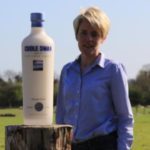
The brand does around 10,000 9-litre cases in the US and currently is in New York Metro, Colorado, New Hampshire, Kansas, South Carolina and Massachusetts. Mary is smart enough to know the US market and is looking at LibDib (and other approaches) to expand into Wisconsin, Illinois, Florida, California, as well as Maine Vermont and New Jersey.
Globally, the brand is in Ireland (of course) and elsewhere in the UK, Germany, Australia, and Alberta Canada.
My takeawayFrom a personal perspective, my wife and I have always been Bailey’s Irish Cream lovers, considering it as a special treat, upon occasion. However — and at the risk of offending my Diageo friends — Coole Swan is at an entirely different level of cream liqueurs. It is, as the label indicates, a “Superior Irish Cream Liqueur.”
I’m well aware of the trend toward low and no alcohol and one might wonder as to whether the drinking climate will inhibit the growth of all cream liqueurs. However, the sales data shows that the leading brands, have grown one percent recently — basically flat but not declining. With all due respects to the trend followers, not everyone buys into it (what’s the point of drinking a no-alcohol tequila) and, regardless, a bit of indulgence goes a long way these days.
The challenge Coole Swan faces is resources, and, to make the brand grow by expanding in current markets, adding meaningful and strategically important new markets, building awareness and trial, and the human resources to make all this happen.
What Mary and her team have going for them, and why I believe in the growth potential of the brand, is tenacity, passion, intelligence, and strategic thinking. They need that and more to make a dent in the category and Bailey’s sales.
I love a good David vs. Goliath story. Don’t you?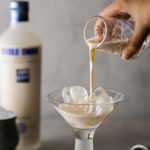
December 3, 2020
Misunderstood Whiskey
What I particularly enjoy about the craft spirit movement is that it attracts people with vision and who are willing to think outside the box. This is the story of two childhood friends who had an idea and the tenacity to make it happen, in no less a difficult and complicated endeavor than the spirits business.
JD Recobs and Chris Buglisi, founders and owners of Misunderstood whiskey, have been friends since childhood, age seven to be exact. They grew up a block apart in Montclair, NJ and often worked together in various “enterprises” ranging from lemonade stands to DJ events to house painting.
Their college years were characterized by the usual and expected choices until graduating. The end of college and entering the workplace also brought a graduation from Captain and Coke to bourbon. Unfortunately, their ardor for whiskey was not shared by their friends who hated whiskey. And, yet their friends were drinking flavored whiskey and liking it. A eureka moment followed and the idea of a new and different flavored whiskey came to the surface.
As they put it on their website:
“We started this business with absolutely no experience besides drinking the stuff. We just had a vision. This made us work harder to develop a unique, high quality whiskey that was the perfect balance between complexity and drinkability. We spent many sleepless nights running home from our corporate jobs to blend, infuse, and spit out lots of homemade infusions. In 2017, after four years of development and feedback, we finally bottled Misunderstood Ginger Spiced Whiskey. The next question was, would anyone buy it?”
The Journey
Satisfied with the product they had developed in their kitchens, the path to launch involved the usual obstacles — finding a manufacturer, raising money, getting distribution, and much more. Fortunately, they found a manufacturer in Bardstown, KY and began production of what they describe as the whiskey for everyone — “an introductory whiskey for the novice yet complex enough for the connoisseur.”
So, after bottling their first run, they drove overnight back to New Jersey with cases in their car and launched at The Jersey City Whiskey Fest (the inaugural event in 2017) and 1,500 thirsty attendees. On the way they dropped off cases to an online retailer. They quickly depleted their first production run.
Here’s how they describe the reaction to Misunderstood Whiskey:
“1,500 people were in attendance to taste products showcased by nearly 100 established brands…and well, us. Much to our surprise, we were overwhelmed by the people’s reactions as Misunderstood became a crowd favorite that night. No one actually believed it was our first day in business. We immediately knew we had something people wanted …”
What followed next was a back office and distribution relationship with Park Street Imports and adding Florida and Upstate NY to their market repertoire. And, if you can imagine, all initially sold by the guys and delivered by them.
As many startup booze business entrepreneurs will tell you, launching a brand is not for the faint of heart or the lazy.
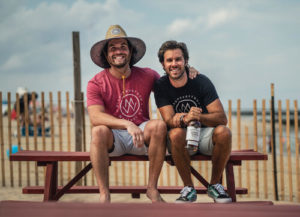 JD and Chris
JD and ChrisEnter 375 Park Avenue Spirits
Sean O’Rourke was the head of the craft spirit division at Fedway Associates, an important and powerful distributor in New Jersey. Sean is one of those executives with a strong entrepreneurial orientation and a keen eye for high potential brands. Somehow, he knows intuitively which craft or startup will make it. So, when he heard glowing reports about Misunderstood from the trade, he reached out to JD and Chris and added them to his portfolio. It quickly became the number one craft brand at Fedway.
The scene shifts. Sean left Fedway and joined the Sazerac Company, which in addition to the namesake brand company, also has the Bond & Royal and 375 Park Avenue Spirits divisions. Sean is the GM of Bond & Royal. As luck would have it, Sean ran into the guys at the Louisville Airport and what followed was a press release with this headline:
MISUNDERSTOOD WHISKEY BECOMES FIRST DOMESTIC BRAND TO JOIN SAZERAC’S GROWING 375 PARK AVENUE SPIRITS PORTFOLIO
They have entered into a strategic alliance with plans for regional and national rollout over time. According to Sean, “JD and Chris set out to make a whiskey for everyone and it has proven to resonate with novice drinkers and cocktail enthusiasts alike. In an age of fleeting brand loyalty and increased consumer curiosity, Misunderstood is one of the few brands I’ve seen consumers return to time and time again as a staple in their pantry and cocktail repertoire.”
Jason Schladenhauffen, president and CEO of 375 Park Avenue Spirits, added, “The success that Chris and JD have been able to achieve…is a testament to the strength of the brand and the stewardship they’ve provided,”
I’ve always said that for a new brand to succeed, it needs to be relevant and unique. But let’s also add the drive, enthusiasm and hard work of the founder.
About the product
Misunderstood is an American Whiskey blended with two types of all-natural ginger. In fact, the ginger is visible (well ground up) in the bottle and collects at the bottom if it’s left to sit for a while. The product is distilled at 80 proof from 100% Midwest grains in Bardstown KY, and aged in American Oak barrels. The SRP is roughly $30 for a 750ML.
I’m not much of a taste expert but their description resonated with me as I drank the product. The aroma (nose) provides ginger (of course), but also vanilla, and a bit of citrus. I loved the taste — ginger bread, toasted oak, caramel, vanilla. The finish is a very enjoyable butterscotch and baking spices.
I tried it many different ways, but on the rocks with a twist of lemon peel was my favorite. I asked about a signature drink and was told that the “Stood and Soda” (a High Ball) was becoming popular. It is not a shooter product, in my view, but a very pleasant sip and savor experience. As you can imagine the Misunderstood Mule is outrageous.
* * *
The obvious question is, what’s ahead for JD and Chris. With 375 Park Avenue Spirits providing the wind to the brand’s back and with their work ethic the formula for success is there. Remember, a winning new brand needs relevance, uniqueness and hard work by the founders.
Interestingly, the subtitle on the label is “Legend One.” So, I’m guessing that Misunderstood Ginger Spiced Whiskey is just the beginning.
The post Misunderstood Whiskey first appeared on Booze Business: A Blog Dedicated to the Business of Spirits and Wine.
August 13, 2020
Miramar Rakia From Bulgaria: The American Dream
The phrase and concept of The American Dream comes from James Truslow Adams in his book, the Epic of America. This definition will set the stage for the story you are about to read:
The American Dream is the belief that anyone, regardless of where they were born or what class they were born into, can attain their own version of success in a society where upward mobility is possible for everyone. The American Dream is achieved through sacrifice, risk-taking, and hard work, rather than by chance. (Source)
Selena Nitz, founder and owner of Miramar Rakia Modern Brandy, emigrated from Bulgaria in 1999 with the intention of living the American Dream. Through hard work and perseverance, she is on her way toward accomplishing her goal via a unique and interesting product from her home country.
Let’s start with her story…
Selena grew up in Communist Bulgaria on a farm in the countryside. Among other crops, her father and grandfather had a vineyard and made wine and Rakia (more about this in a moment). While the farm life was pleasant, surrounded by friends and family, once the Communist regime was over, she yearned to come to America with her daughter. Not an easy feat, considering the difficulty in getting a visa, the cost and the fear of rejection. Once rejected by the American embassy, it could take a decade or more to get one, if ever.
Despite the obstacles, Selena, a single mom, set her mind on a new life for her and her child in America. She sold everything she had, hired someone to coach her on what to do and how to act during the interview process. All she had left was the money for an airplane ticket, plus $200. More than that, she had a dream and the tenacity to make it come true.
It took her from 1991 to 1999 to make it happen.
I asked her how her family felt about her leaving. She told me she had to buy a round trip plane ticket in order to get her visa. Her father told her she will use the return ticket because she will give up, “you have no idea of where you’re going.” She ripped up the ticket and said to herself, “there’s no way back, that’s it.” Did I say tenacious? Add feisty to the list.
Coming to America
She landed in New York, Brooklyn to be precise, and what followed was a series of odd jobs in restaurants and English lessons from her daughter who learned the language quickly.
After two years in NYC, they moved to Chicago where Selena worked in various restaurants and studied to become a hairdresser and cosmetologist. But an important moment came while working bars and restaurants in downtown Chicago. She decided to become a citizen and began thinking about the booze business.
Her American citizenship ceremony resonated with me and should also to anyone whose family emigrated to the USA. Selena describes it as inspiring and memorable, with the Judge telling those who took part that they came into his court from 44 countries and will leave through the same door as one, as Americans. She went on to tell me what else he said:
“We welcome you to America but at the same time, we don’t want you to change. Actually the opposite, we want you to stay who you are and take something from all of your cultures… that you have in your heart or your traditions, cuisine or any habits, and share with us so you can enrich our culture even more.”
As her new life in Chicago began to take shape, Selena often thought about the bottle of Rakia she brought with her at the urging of her father. He had said “take this with you to America… it will remind you of home… and share it with your American friends.”
Suddenly, the thought struck her about the spirits industry based on articles and news reports about the business, brands, their development and sales. She thought, there are all types of spirits out there but no Rakia. Why is there no Rakia?
So, Selena went back to Bulgaria, drove from border to border, visited over 30 distilleries and finally found the best Rakia makers in the country.
What is Rakia?
This is from her website:
Rakia is the collective term for fruit brandy very popular in Central and Southeast Europe. Because it’s made from fruits, it’s categorized as “brandy”, but it’s nothing like brandy… It can be made with many fruits but grape and plum are the most popular.
The countries making their own variation of Rakia include, Albania, Serbia, Croatia, Turkey, Macedonia, Romania, and Moldova. Each has its own adaptation and uses a wide range of fruits. In Bulgaria, grapes, plums, and apricots are most frequently used as a raw material.
The Bulgarians claim that they were the first to create Rakia, based on pieces of pottery from the 14th century, and they have taken measures to declare it a national drink. “A psychotherapist can help you but Rakia is cheaper” — is a contemporary proverb many Bulgarians swear by.
Selena’s Rakia – Miramar Modern Brandy
Back to her journey. The makers she found are located on the coast of the Black Sea, have their own vineyard and have been making Rakia for nearly a century. But, she had a vison of what the product should taste and be like and painstakingly described the start, the finish, and the type of smoothness she wanted.
From the back label: “The Miramar Experience… a 23-step continuous distillation process [that] honors the Rakia tradition, yet modernizes it to create an extraordinarily smooth long finish.”
Miramar Rakia is created with rare, handpicked Muscat Ottonel grapes from a single estate. They recently won a double gold medal from the SF World Spirits Competition, thereby creating a Rakia category.
Ah, therein lies a tale. Our friends at the TTB were reluctant to approve the brand because, as far as they were concerned, there is no such category as Rakia. It took four months and much back and forth. So, instead of creating a category, they approved the brand — Miramar Rakia Modern Brandy. I imagine the back and forth as going something like this:
TTB: There’s no such thing as Rakia. We never heard of this category.
Selena: But the EU recognizes it as a category and has for many years.
TTB: No, no, we don’t have this in America.
Selena: Well, this doesn’t mean it doesn’t exist, right? Okay, if you don’t want to accept this as a category I’m going to make it as a part of my brand name.
TTB: There’s no such thing as modern brandy.
{More time, more emails and many more phone calls follow. Finally, …}
TTB: Okay, fine. You can have it. Have modern brandy, okay? Whatever it is, just leave us alone.
Those folks from the TTB are such jokesters.
By the way, you’ll find it in the brandy/cognac section.
Off to market
From a route to market standpoint, Selena has made some very smart moves.
She has an exclusive distribution arrangement with Southern Glazer’s Wine and Spirits, not an easy accomplishment. They test marketed the brand in south Florida and it did well. The idea of a clear brandy, in a category no one ever heard of was just the right combination of “unique” and “willing to try.” It is very mixable and you might want to check out the recipes on the website.
As is the case for nearly all startup/emerging brands, the Covid virus interfered, so she cleverly pivoted and began selling Miramar direct-to-consumers using Passion Spirits (where I bought a bottle). They are now shipping to 28 states from Florida. They are also talking about going into Illinois with an eye toward Binny’s 40+ locations.
Along the way, she persuaded a former Seagram colleague, Phil Gervasi, to join her. As Selena puts it, “Phil is my secret weapon… he’s been my mentor and been with me every step of the way.”
Phil held many senior sales positions at Seagram, worked at Diageo where he was senior vice president/general manager for California and several western states. His most recent position was EVP, North America Sales for Patron. In fact, it was a former colleague from Patron that introduced her to Phil.
She couldn’t have picked a better person to work with. Or a smarter, nicer guy.
* * *
Selena Nitz is indeed living the American Dream. At a period in the history of this country where some question and even oppose immigration, I’m proud to know her and share her story. Her journey reminds us that what made America truly great was the willingness to open our doors and provide opportunities to those willing to work hard to accomplish the dream.
As to Miramar Rakia Modern Brandy, I’ll close with this comment from one of the judges at the SF competition:
“It’s very unique because it’s a little floral on the nose and I’m ready for it to be sweet. But when I drink it, it’s almost like fine tequila. This is very hard to achieve.”
The brand sells for $39.99 (750 ML), 40 AbV (80° proof) has no additives, is gluten and sulfate free, non-GMO, and nothing artificial.
The post Miramar Rakia From Bulgaria: The American Dream first appeared on Booze Business: A Blog Dedicated to the Business of Spirits and Wine.

